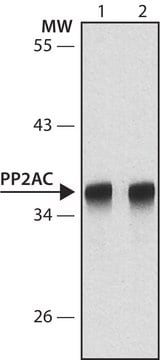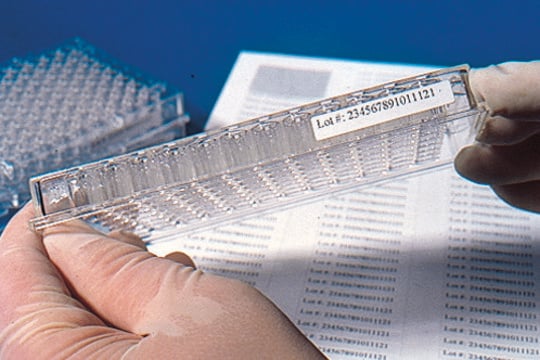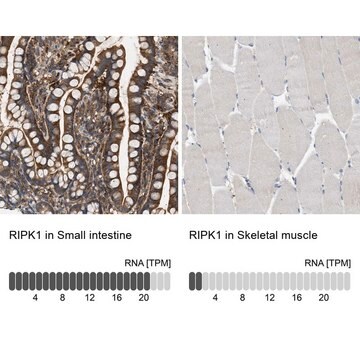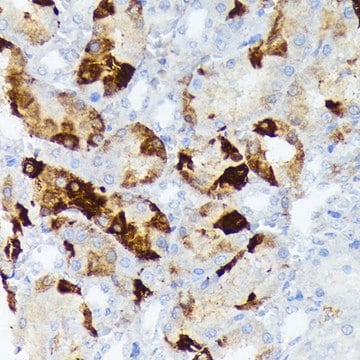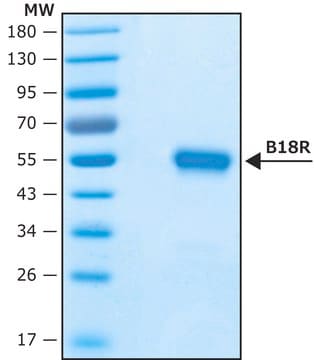PC116
Anti-ATM (Ab-3) (819-844) Rabbit pAb
liquid, Calbiochem®
Sinónimos:
Anti-Ataxia Telangiectasia
About This Item
Productos recomendados
biological source
rabbit
Quality Level
antibody form
purified antibody
antibody product type
primary antibodies
clone
polyclonal
form
liquid
contains
≤0.1% sodium azide as preservative
species reactivity
human
manufacturer/tradename
Calbiochem®
storage condition
do not freeze
isotype
IgG
shipped in
wet ice
storage temp.
2-8°C
target post-translational modification
unmodified
Gene Information
human ... ATM(472)
General description
Immunogen
Application
Immunoprecipitation (2 µg)
Packaging
Warning
Physical form
Analysis Note
GM02052A cells
Daudi or HeLa cells
Other Notes
1. Anti-ATM (Ab-3) Rabbit pAb immunoblots and immunoprecipitates a 350 kDa protein in lysates of normal and transformed cells or tumor lines derived from individuals homozygous wild type for the ATM gene; whereas in cells derived from patients with Ataxia-Telangiectasia and carrying homozygous inactivating mutations in ATM, no 350 kDa protein is detected.
2. Anti-ATM (Ab-3) Rabbit pAb may non-specifically detect smaller molecular weight proteins present in both ATM mutant and wild type cells. Careful titering of primary and secondary antibodies is recommended.
3. Immunoblotting of p350ATM requires loading 100-150 µg cell lysate on low percentage acrylamide gels (5%) (SDS/PAGE) with electrophoresis performed until the 200 kDa molecular weight marker has migrated halfway through the gel. Semi-dry electrophoretic transfer is for 2 h at 9V constant voltage. Tank transfer is overnight at 40 V constant voltage.
4. To transfer the gel for blotting, lay a dry piece of Whatman 3MM Chromatography paper over the wet gel. Carefully peel the 3MM paper and gel off the glass plate and immerse, gel side up, in transfer buffer until 3MM paper is thoroughly wet. Remove bubbles by rolling a pipette across the surface of the gel.
5. To confirm detection of p350ATM, a cell line carrying a truncating mutation in ATM should be used as a negative control. Cell lines from A-T patients which show no detectable band at 350 kDa, can be obtained from the National Institute of General Medical Sciences Human Genetic Mutant Cell Repository at the Coriell Institute for Medical Research, 401 Haddon Avenue, Camden, NJ 08103.
6. For immunoprecipitations, prepare nuclear lysates as described. Immunoprecipitate p350ATM using 2 µg of Anti-ATM (Ab-3) Rabbit pAb and Protein A-Agarose (Cat. No. IP06). Detection can be after metabolic labeling with 35S methionine followed by autoradiography, or alternatively, immunoprecipitated proteins can be displayed on 5% SDS/PAGE, transferred to nitrocellulose and then blotted as above using Anti-ATM (Ab-3).
Meyn, S.M. 1995. Cancer Res.55, 5991.
Paules, R.S., et al. 1995. Cancer Res.55, 1763.
Savitsky, K., et al. 1995. Science268, 1749.
Savitsky, K., et al. 1995. Hum. Molec. Genet.4, 2025.
Zakian, V., 1995. Cell82, 685.
Beamish, H., et al. 1993. Rad. Res.138, 130.
Kastan, M.B., et al. 1992. Cell71, 587.
Painter, R.B. and Young, B.R. 1980. Proc. Natl. Acad. Sci. USA77, 7315.
Legal Information
Not finding the right product?
Try our Herramienta de selección de productos.
Storage Class
10 - Combustible liquids
wgk_germany
nwg
Certificados de análisis (COA)
Busque Certificados de análisis (COA) introduciendo el número de lote del producto. Los números de lote se encuentran en la etiqueta del producto después de las palabras «Lot» o «Batch»
¿Ya tiene este producto?
Encuentre la documentación para los productos que ha comprado recientemente en la Biblioteca de documentos.
Nuestro equipo de científicos tiene experiencia en todas las áreas de investigación: Ciencias de la vida, Ciencia de los materiales, Síntesis química, Cromatografía, Analítica y muchas otras.
Póngase en contacto con el Servicio técnico



